This is the third in a series of articles on the 2010 San Francisco International Film Festival, held April 22-May 6.
Justified since 2001 as components of the “global war on terror,” the invasions of Iraq and Afghanistan have always been an attempt to impose US dominance over a strategic area of the Middle East and Central Asia. A continuum exists between the Bush and the Obama administrations, whatever their tactical differences, on their conduct of the occupations.
Of late, highlighted by the honoring of The Hurt Locker at the most recent Academy Awards ceremony, sections of the liberal establishment and intelligentsia have turned toward rehabilitating the two wars. These upper middle class layers have now climbed aboard the military train.
In reality, the “global war on terror” is a code phrase for neo-colonial wars of conquest. The militarization of US foreign policy, whose aggressive escalation is occurring under Obama, threatens the whole of humanity.
Despite this palpable reality, the election of Barack Obama has reduced the official anti-war movement more or less to silence. The professional protest groups who opposed George W. Bush have set up a new franchise: keeping hope alive in Obama and the Democratic Party. This operation exerts considerable pressure, even on well-meaning artists. Further, the media relentlessly churns out war propaganda that sings the praises of the military.
However, to the extent that filmmakers accept any of the premises of the “war on terrorism”—that the current conflicts are indeed about terrorism; that the US military effort, while perhaps ham-fisted, is a legitimate response to 9/11; that Washington’s aim is to promote “democracy” in the region—they will be politically and artistically hamstrung. They may criticize this or that aspect of US policy, even quite sharply, but they will miss its driving force. The artistic results will tend to be passive or timid.
Many filmmakers now fly the banner of “nonpolitical” over their work, as if a serious grappling with the politics of a phenomenon were the kiss of artistic death. Outrage, taking a strong stance, speaking out against authority, all of this has somehow become identified with “didacticism,” and even Stalinist “socialist realism.”
Yet contorting oneself to avoid saying the harsh and sometimes unpalatable truth creates its own problems. Artistic “bad faith” makes itself felt in the bone and marrow of a film. We know when the director or writer is pulling his or her punches. Moreover, art also abhors a vacuum. Refusing “to take sides” and merely planting oneself in the immediately given facts, which go unexamined, leaves the artist vulnerable to the dominant social forces and politics.
Of course, it must be said that the notion that one can treat a war “nonpolitically,” when the driving force is geopolitics, is simply absurd. These are, above all, world-historical political events.
Without consciously working through the social and historical character of a given war, one is vulnerable to the falsehoods promoted by the ruling elite. For example: Yes, there have been blunders, but, as one director said at the festival, not all Great Power interventions are necessarily bad. After all, isn’t it necessary to fight terrorism? Can’t there be a democratizing component in such interventions? Etc.
Several documentaries screened at the San Francisco festival criticized aspects of the current US interventions.
During question-and-answer sessions, the directors of The Oath (American Laura Poitras) and Restrepo (co-director Tim Hetherington from Britain)—which deal with the conflicts in Iraq and Afghanistan, respectively—described some of the perils of filming in war zones or contested regions. The courage and self-sacrifice demonstrated by these filmmakers was certainly striking.
But neither documentary is overtly anti-war, nor explicit about the colonialist character of these conflicts. This reviewer asked Restrepo’s Hetherington whether he was an opponent of the Afghan intervention, to which he could not give an unequivocal reply. He acknowledged at another point that “war is absurd,” but claimed that in making the film, “we really did not care about politics. Whether you are left or right wing—these guys [US soldiers] need to be respected.”
The Oath’s Poitras, in her question-and-answer session, made clear her opposition to the torture and abuse at Guantánamo and criticized the undemocratic Military Commissions, which have undergone another revision under Obama. She too, however, never condemned the war outright.
The Oath
Poitras’s movie deals with two men: Abu Jandal, Osama bin Laden’s former bodyguard, and Salim Hamdan, a former detainee at Guantánamo and the first man to face a US military tribunal. The “oath” of the title is the Al Qaeda loyalty oath taken by both men.
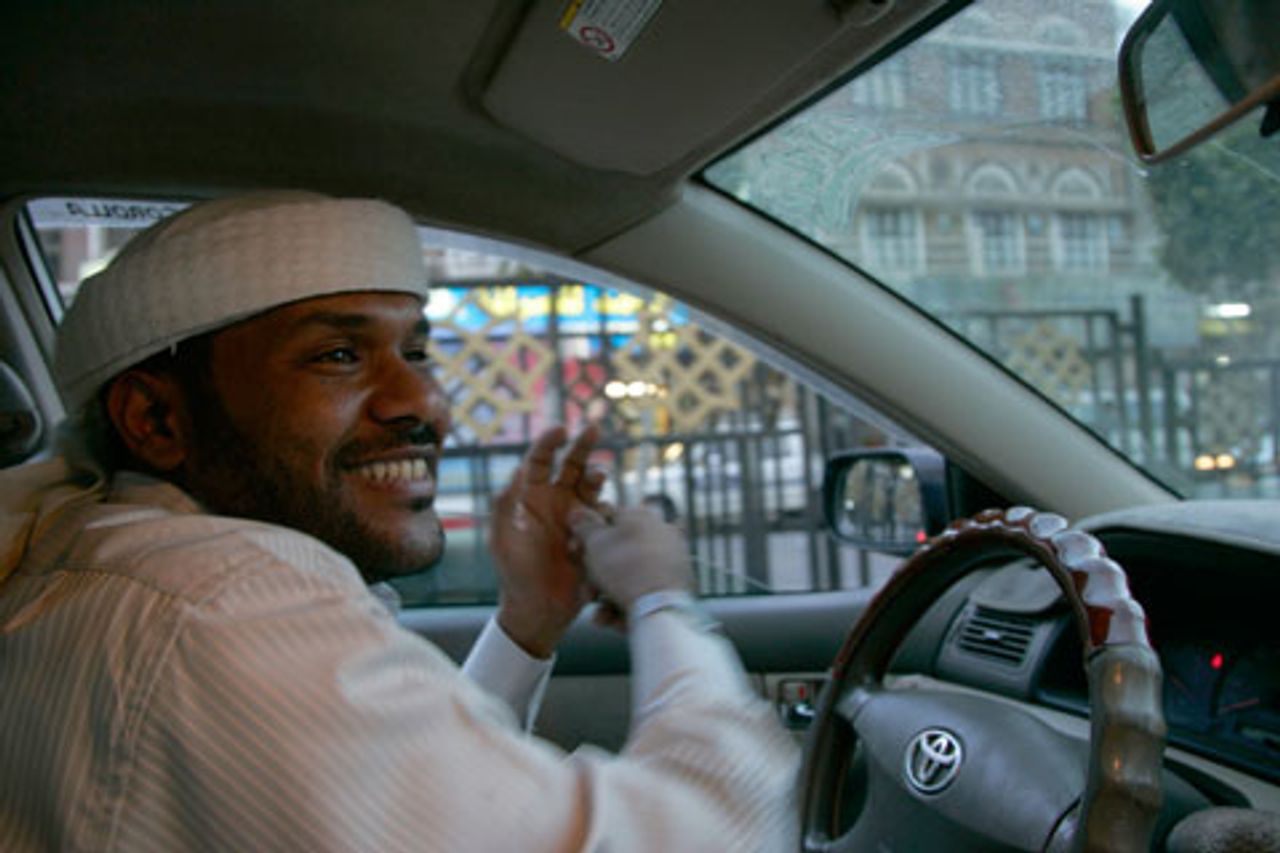 The Oath
The OathFilmed in Yemen and Guantánamo Bay, Cuba, The Oath is the second documentary in a trilogy—the first being My Country, My Country (2006)—planned by Poitras, who is attempting to process the “twin tragedies” of 9/11 and its repercussions: “Guantánamo, the invasion of Iraq, legalization of torture.”
Of My Country, My Country, the WSWS wrote that the film “is a rather tame portrayal of the present situation in Iraq…[which] proceeds in fits and starts, without thoroughly examining any single phenomenon.… [T]he director’s attitude toward the colonial-style occupation is never made clear.”
Much the same can be said about The Oath.
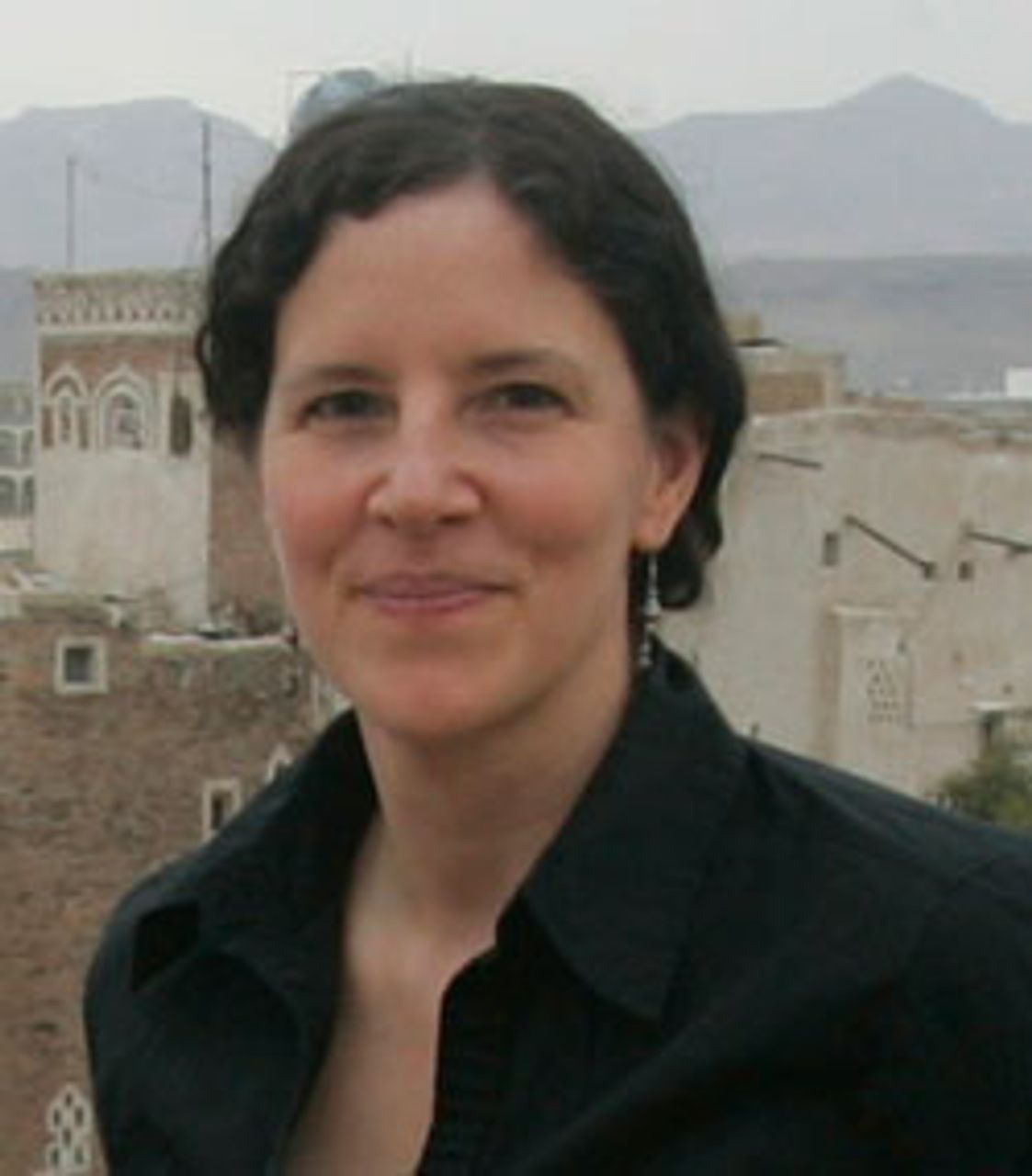 Laura Poitras
Laura PoitrasWhen the 9/11 attacks occurred, Abu Jandal was in prison in Yemen. Six days after the bombings, he was interrogated by the FBI. Having met many of the hijackers at Osama bin Laden’s hospitality house, Abu Jandal provided high-level information. In fact, during a segment of 60 Minutes that featured an interview with Abu Jandal, Michael Scheuer of the CIA asserts: “Oh, I think he’s probably far more important than anybody we’ve got in Guantánamo.” Curiously, Abu Jandal was subsequently released and set up as a cab driver in Yemen.
Salim Hamdan does not appear in the film. But he is present through a reading of his moving letters to Abu Jandal, a tape recording and a grainy short film of his original arrest. Throughout the movie, Abu Jandal expresses guilt for having introduced Hamdan to Al Qaeda in the mid-1990s. Bin Laden then arranged for the two to marry sisters and Hamdan became his driver. Footage of Hamdan’s military and civilian attorneys at Guantánamo insisting their client was never more than a mechanic and driver is riveting.
(During her question-and-answer period, Poitras said it was a mystery as to why the fates of the two men were so different. Hamdan spent more than seven brutal years in American captivity: he was arrested by Afghan forces in Kandahar in September 2001, transferred to Guantánamo is May 2002, and released in January 2009. In 2006, the US Supreme Court ruled in his favor in the landmark Hamdan v. Rumsfeld case. Hamdan’s Supreme Court victory, however, did not lead to his release, but rather to Congress redrafting the law on military tribunals and inventing new charges against him.)
The film’s original focal point was meant to be Hamdan, but due to lack of access—no filming was allowed at Guantánamo, and Hamdan shunned reporters after his release—this proved impossible. The alternate protagonist, Abu Jandal, is something of a lost soul, who takes up much of the film so that Poitras can prove Islamic radicals are real people. Not much light is shed by concentrating on his current life and utterances, although at one point, he says he is against the policies of the West, not its people.
The Oath is markedly devoid of any historical context. Jandal is a deeply confused, ex-member of bin Laden’s entourage. But without any reference to the role played by Washington in arming and promoting fundamentalism and figures such as bin Laden in Afghanistan in the 1970s and 1980s in order to undermine the USSR, the film could conceivably be viewed as a defense of the “war on terrorism,” albeit shorn of its excesses: torture, illegal detentions and show trials.
Restrepo
British-born photographer and filmmaker Tim Hetherington teamed up with American writer and journalist Sebastian Junger to create a feature-length documentary that records the deployment of a platoon of US soldiers in Afghanistan’s Korengal Valley. From May 2007 to July 2008, Battle Company of the 173rd Airborne Brigade was stationed in one of the most dangerous postings of the war. The remote outpost was named “Restrepo” in honor of the unit’s medic, Juan Restrepo, who was killed in action.
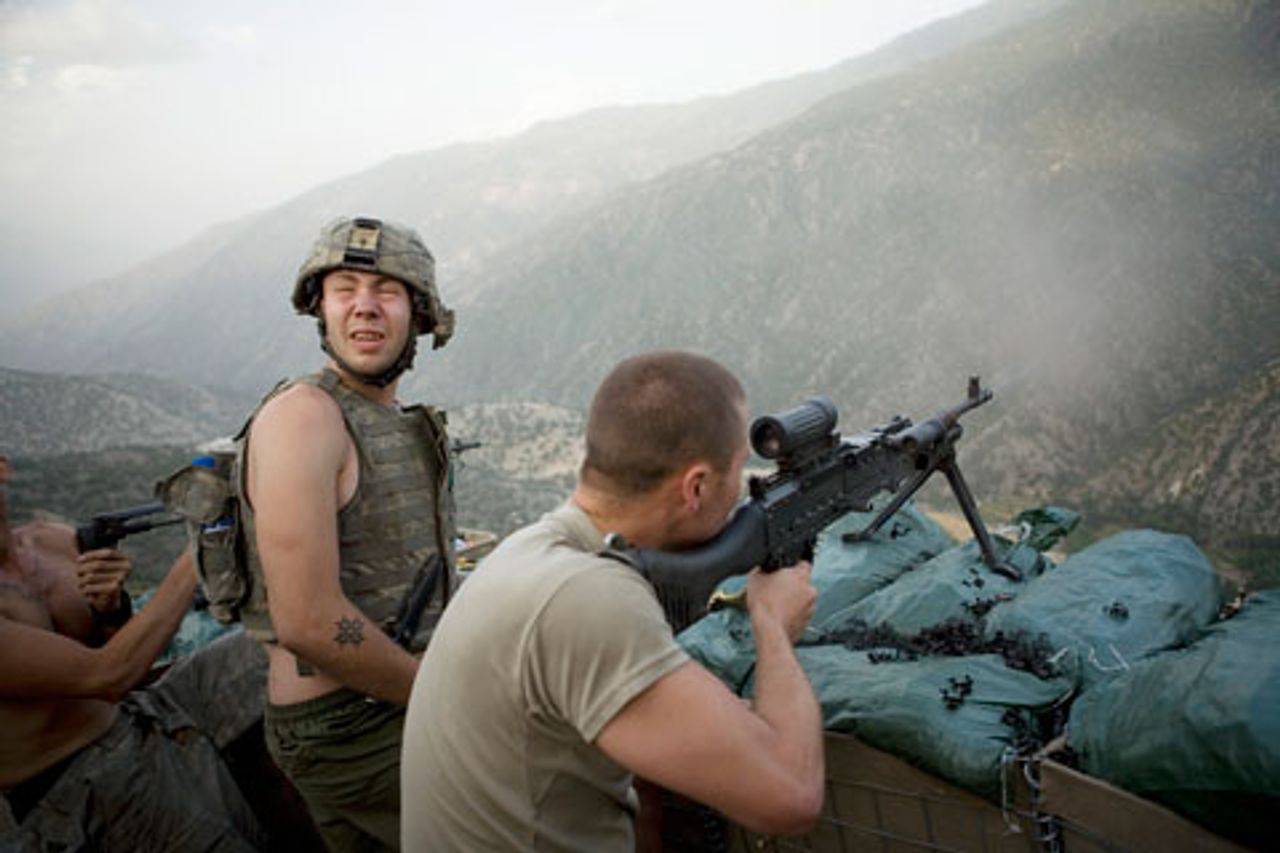 Restrepo
RestrepoThe Korengal Valley, six miles long near the Pakistani border, is surrounded by mountains that rise to heights of 10,000 feet. Some of the film’s most remarkable shots offer panoramic views of the stunning rugged slopes, speckled with shacks inhabited by a poor and resentful population.
According to the film’s production notes, the Korengal Valley was considered “to be a crucial relay point for Taliban fighters moving from Pakistan toward Kabul [Afghanistan], and several top Al Qaeda leaders were thought to have used it as a base of operations…. By the end of 2007, almost one fifth of all the combat in Afghanistan was taking place in the Korengal.”
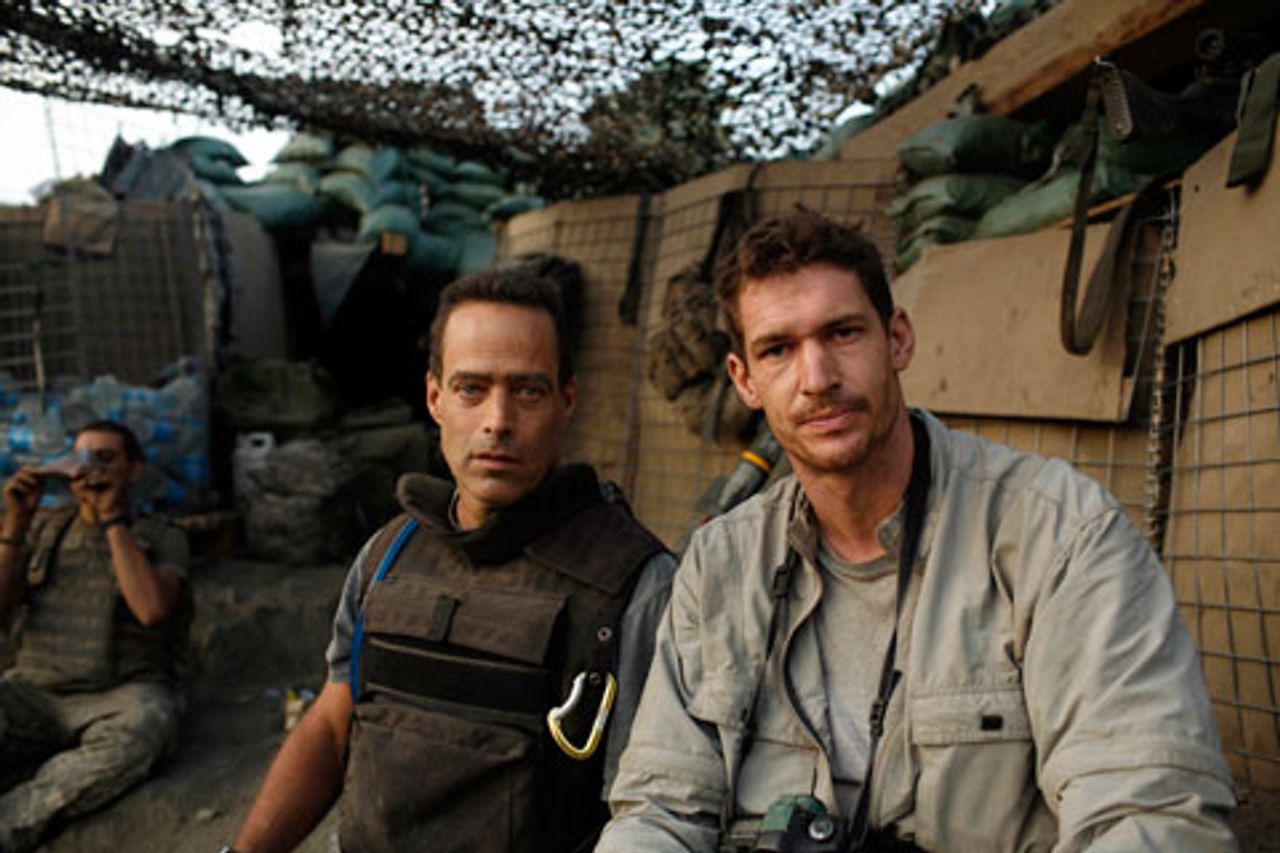 Sebastion Junger and Tim Hetherington
Sebastion Junger and Tim HetheringtonBy the finish of the deployment, the directors had shot 150 hours of film. Both at Restrepo, where the unit’s daily life is chronicled, and at the US base in Vicenza, Italy, where the soldiers are redeployed, the latter puzzle over the goal of their mission: “What are we doing here?” We’re like “fish in a barrel,” “I’m going to die here,” are typical comments made by the young men required to put their life and humanity on the line.
The weekly “shuras” (consultations) conducted by the platoon’s captain with the village elders—all the young Afghan men have gone off to join the anti-occupation insurgency—reveal the fraudulence of the American “hearts and minds” campaign. The captain is hard-pressed to assure the elders that he is “wiping the slate clean” and will not follow his predecessor in detaining “everybody” and landing them in the notorious Bagram prison. The Americans, says the captain, are prepared to throw money around, build roads and provide jobs as long as the population cooperates. His promises fall on deaf ears.
Operation Rock Avalanche is launched. A helicopter attack results in five dead civilians—”Show me which ones are Taliban!” cries a grieving and outraged villager. A mother and her children look on in shock. The audience is never told the identity of the victims of this US atrocity. The camera lingers on an infant whose body is covered with shrapnel wounds. These images are assiduously kept from the American and world’s public.
The film’s Italian portion was filmed three months after the termination of the soldiers’ Afghan deployment, around the time post-traumatic stress disorder normally sets in. Some 80 percent of the unit is on medication. One combatant is on four or five different sleeping pills, and another says wistfully, “I have not figured out how to deal with this inside.” What is universal among the soldiers is the desire to never set foot in Afghanistan again.
After the screening, Hetherington rhetorically asks the audience: “How many body bags are required? Where is the line in the sand for the administration?” The filmmaker admitted that “nobody likes to be occupied.” He insisted that “young men are instrumentalized by the state to kill” and that he seeks to explore the attendant “spiritual damage.” He thinks, however, this can be done without calling the war by its proper name, which greatly weakens his endeavor, despite all the heroics and good intentions.
14-18 Le bruit et la fureur (The Noise and the Fury)
French director Jean François Delassus’s documentary about World War I opens by stating that “all of the great catastrophes of the century were born of the 1914-1918 war,” the slaughter that killed 10 million and wounded 23 million more. This is one of the more acute generalizations offered in the film. “My faith did not survive,” adds the narrator, a fictional French soldier who comments rather bitterly—in journal- or letter-style—on the events and experiences captured in the (colorized) film footage.
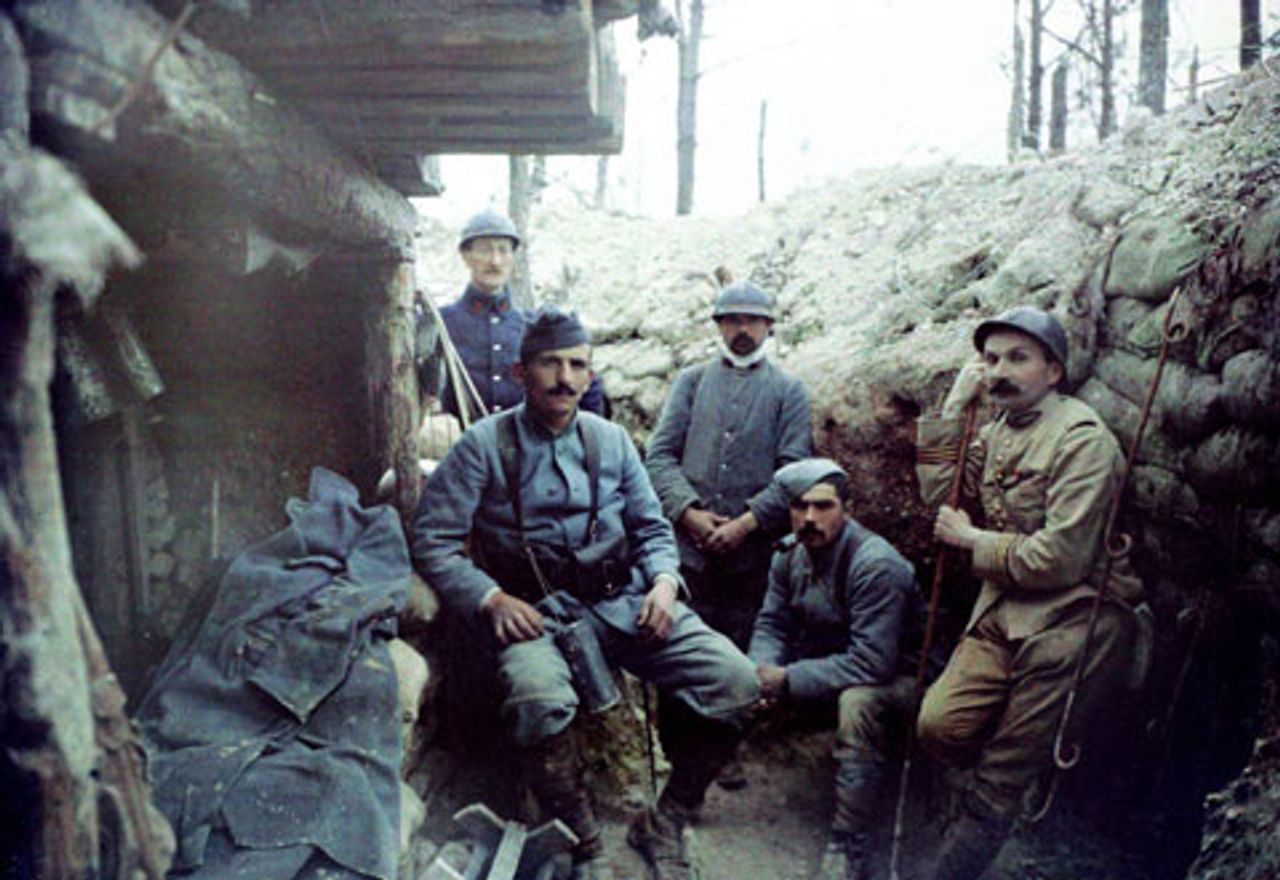 14-18 Le bruit et la fureur (The Noise and the Fury)
14-18 Le bruit et la fureur (The Noise and the Fury)Much of the archival material is compelling. Besides the numerous battle, trench and behind-the-lines scenes, memorable moments include a clip of French Socialist Party leader Jean Jaurès—whom the narrative voice describes as the “only hope” of forestalling the war—returning from Germany. Just before his assassination on the eve of the world war, he declares: “German workers will not go to war against French workers.”
On the other hand, legendary French actress Sarah Bernhardt is shown telling the French population: “Form your battalions. Now we must hate Germany!”
Punctuating the film are clips relating to the war taken from works by Charlie Chaplin, D.W. Griffith, Lewis Milestone and others.
The narrator describes the horrors of trench warfare, of poison gas, of the suicidal attacks against machine-gun nests. He details the almost unimaginable death totals: “25,000 French dead in a single day,” “150,000 French dead in 10 days” in the Ardennes. He points to the mass executions of soldiers in the first months of the war, 500 during “that fine summer of 1914.” The unknown soldier explains about the French propaganda campaign, which broadcast every real or imaginary atrocity committed by the Germans, “a rabid hate campaign.” Year by year, he goes through the events of the war.
At Verdun, in northeastern France in 1916, there was “indescribable savagery.” The bloody 10-month battle claims 400,000 lives from both sides. “Deus ex machina [God from the machine]…. The massacre has become industrialized,” says the narrator. During the first day of the Battle of the Somme in July 1916, the British army suffered nearly 60,000 casualties, including 19,000 dead. The ineptitude, stupidity and brutality of the various high commands are made clear.
A passing reference is made to the Russian Revolution and the Bolsheviks (“I admire them”) who took Russia out of the war.
The Treaty of Versailles, the postwar disaster in Europe, the French occupation of the Ruhr in 1923.… The soldier ends disillusioned, unable to sleep after the war, dreaming of battlefields.
But when it comes to explaining the war, the film falls down almost completely. The various populations are blamed! Delassus has discovered an unpleasant reality: the war was “freely consented to.… We were all right behind the war.”
As the film’s notes assert: “This documentary tries to explain the inexplicable: how tens of millions of men could have suffered the unbelievable toughness of life in trenches during 4 years, season after season, day after day, night after night? How could they have accepted the idea of a sure death or injury while they could not even tell the exact reason why they were fighting? What you are about to see can seem crazy: WW1 was maintained by a general consent.”
This has sinister implications. More than anything else, it absolves the contending capitalist powers, who “were led to struggle for the subjection of the world-embracing economic system to the profit interests of the bourgeoisie of each country” in the First World War, as Trotsky explained. “The present war,” he went on, “is at bottom a revolt of the forces of production against the political form of nation and state. It means the collapse of the national state as an independent economic unit.” It also meant the collapse of the existing workers’ organizations who had led the European population into the bloodbath, a small fact that Delassus ignores.
One should also bear in mind that along with presenting a good deal of interesting material, Delassus has his narrator declare, apparently without irony, that the war, after all, was critical for “the survival of the French nation.” One watches the film aware that tensions between France and Germany are today reemerging.
To be continued
